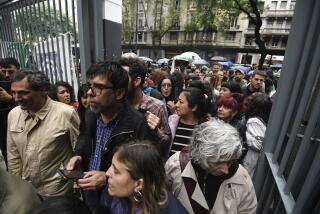Workers in Indiaâs Vast Public Sector Stage One-Day Walkout
NEW DELHI, India â Millions of Indian workers walked off their jobs Friday in a one-day protest against the governmentâs announced plan to close unprofitable state-owned industries as part of an effort to move the country from socialism toward free-market capitalism.
The strike crippled state-dominated industries such as banking, air transport, insurance and energy, but had a lesser impact in industries where Indiaâs private sector is active, such as textiles and manufacturing. Trade union leaders called the protest a major success, while government spokesmen said it had been less effective than they had feared.
There were scattered accounts from around the country of police firing in the air to disperse protesters and union workers attacking public property, but there were no reports of any deaths or intensive rioting. The strike was reported to be near-total in states where Communist parties run the local government or have large representation, such as West Bengal and Kerala. But it was only partially observed in other regions.
The protest marked the first time that workers in Indiaâs vast socialist public sector have staged a major demonstration against the free-market economic reform policies introduced last summer by the Congress Party-led minority government of Prime Minister P. V. Narasimha Rao.
A lifelong socialist recently converted to free-market thinking, Rao has pledged to revive Indiaâs sagging economy by slashing bureaucratic red tape, inviting foreign investment and trimming the governmentâs huge budget deficit, which fuels a double-digit inflation rate.
Raoâs reforms so far have elicited relatively little resistance despite his partyâs lack of a parliamentary majority. This is in part because politicians from across the ideological spectrum say they recognize that with more than $70 billion in debt, thin foreign exchange reserves and dwindling aid from the Soviet Union, India has few alternatives but to join the international rush toward market capitalism.
But leftists outside and inside Raoâs Congress Party warn that they will not tolerate large-scale layoffs of workers in the sprawling but unprofitable public sector.
Indiaâs state-owned companies employ about 2.3 million people, and millions more work in government services such as the railways. But of the 244 largest government companies, more than half are losing money, feeding a federal budget deficit six times larger in relative terms than the one in the United States.
The conundrum facing Raoâs government is that without privatizing or closing unprofitable state-owned enterprises, it may have difficulty achieving its political and economic goals.
For example, senior government ministers see the countryâs inflation rate--officially about 13%, but unofficially estimated at near 20%--as the most politically damaging aspect of Indiaâs economic woes. Yet without slashing the money-losing public sector, the government cannot hope to cut its huge deficit, which economists see as the main cause of inflation here.
Also, while the government hopes to stimulate high growth rates by opening Indiaâs traditionally closed economy and reducing government regulation, Indian and foreign businessmen doubt it can create a genuinely competitive market environment if it insists on protecting and nursing âsick industries,â as money-losing public enterprises are known here.
More to Read
Sign up for Essential California
The most important California stories and recommendations in your inbox every morning.
You may occasionally receive promotional content from the Los Angeles Times.










